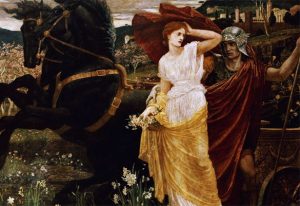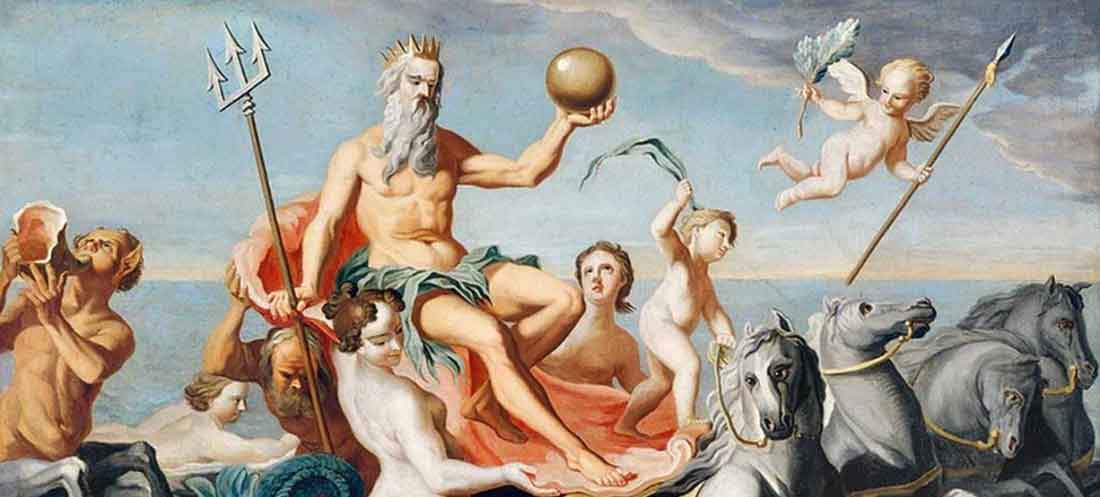The myth of Persephone
 Persephone was the daughter of the goddess Demeter. Her father was Zeus and her husband was Hades. With him she gave birth to Zagrea, Eubouleas and Savazios. Hades took her to the underworld for her beauty. But the Goddess Demeter asked her back. Hades agreed that Persephone would ascend to the upper world for six months and descend to the underworld for the next six.
Persephone was the daughter of the goddess Demeter. Her father was Zeus and her husband was Hades. With him she gave birth to Zagrea, Eubouleas and Savazios. Hades took her to the underworld for her beauty. But the Goddess Demeter asked her back. Hades agreed that Persephone would ascend to the upper world for six months and descend to the underworld for the next six.
So during the months that Persephone is in the upper world, the Goddess Demeter was happy and there was summer, while the others were bad weather. The myth of the rapture first appears in Hesiod’s Theogony. The Homeric Hymn to Demeter is our most important source: it describes how the abduction took place in the Nysian field, when Persephone was gathering flowers in a meadow with the company of the Oceanid nymphs, Athena and Artemis. And while he was gathering a daffodil, the earth opened, and Hades sprang forth in his chariot and seized it. The cries for help were not heard by anyone except Hecate and Helios. Zeus was far away.
Interpretations of the myth of the rapture of Persephone
a) The physical theory of vegetation and the agricultural cycle. It was first formulated in antiquity by the Stoics. Kori is identified with grains and her absence with their storage underground. Her abduction is the allegory of the cycle of nature’s euphoria: the descent of the Maiden into the Underworld each autumn is equated with the absence of fruits, which arise in the spring with her ascent.
However, such an opinion is rejected because, as our main source, the Homeric Hymn, tells us, the Maiden stayed four months in the Underworld and eight months in the Upper World. But cereals germinate only a few weeks after sowing. Also the collection of flowers by the Daughter or the wanderings of Demeter in search of her daughter cannot be associated with agricultural actions.
b) The theory of rebirth and the eternity of life, which stems from the generations springing from one another. This was the essence of the celebration of Persephone’s “ascent” in the Eleusinian Mysteries. The return (rising) of Persephone was celebrated with the autumn sowing. Pluto symbolizes the wealth of wheat that was stored in underground silos or pithus during the summer months. Similar pithos were formerly used for burials, and Pluto is identified with Hades, the ruler of the underworld.
In the summer months Persephone is in the wheat of the underground silos, in the realm of Hades, and is identified with “Persephone”, the queen of the underworld. At the beginning of autumn, when the seeds of the old harvest are sown in the fields, Persephone ascends (rises), and is reunited with her mother Demeter, for the old seed is united with the new shoot. To the initiates, this union was the symbol of the eternity of human life, springing from the generations springing from one another.
c) The anthropological dimension of the myth. This focuses mainly on the human dimensions of the myth: marriage and death – which is dominant in the myth – the traumatic separation of the mother from the young daughter, sorrow and anger and finally reconciliation. There is also the opinion that says that Hades should be considered “sterile, sexually weak, while Persephone represents the amorous adventures of adolescence”.
Persephone’s adventure
From when does Demetra’s mother begin the search for her daughter Persephone, which will make her cross the entire known world? Just as she was disappearing into the abyss, Persephone called out. Dimitra heard her and anguish gripped her heart. He runs, but does not find Persephone!.. They say that for nine days and nine nights, without eating, without drinking, without washing and adorning herself, the goddess wanders the world, holding torches in her hands!
Persephone, according to all texts of ancient Greek literature, is the goddess of the Underworld and the companion of Hades. She is the daughter of Zeus and Demeter, at least according to the most popular version. But one tradition wants her to be the daughter of Zeus and Styx, the River of the Underworld.
The greatest myth of Persephone
The greatest myth of Persephone is the story of her abduction by Hades, her uncle (since Hades was the brother of Zeus).
Hades fell in love with the young woman and abducted her while she was gathering flowers with the Nymphs on the plain of Enna in Sicily (this is the generally accepted location). This abduction took place with the complicity of Zeus and while Demeter was absent. In this era are placed Demeter’s journeys throughout Greece, to find her daughter, whom she mourned wherever she stood.
In the end Zeus ordered Hades to return Persephone to her mother. But this was no longer possible. Indeed the new one had ceased hunger when she was in the Underworld. Out of recklessness had eaten a pomegranate seed. That was enough, to connect him to the Underworld once and for all
To lighten things up, Zeus decided that Persephone would divide her time between the Upworld and the Underworld. The proportions vary among writers; sometimes he spends only a third of the time on earth, sometimes half.
Persephone as the wife of Hades plays a role in the myths of Heracles, Orpheus, Theseus and Peiris She was also said to have fallen in love with the handsome Adonis, who in turn had to divide his time between Earth and the Underworld Persephone appears near Demeter in the Eleusinian Mysteries. In Rome she was identified with Proserpina
How Persephone was kidnapped
Persephone, as we have said, was the daughter of Zeus and Demeter and, at least in the traditional form of the myth, was the only daughter of the goddess Megalone, happy among the Nymphs, in the company of her sisters, the other daughters of Zeus, Athena and Artemis , and was little interested in marriage, when her uncle, Hades, fell in love with her and, with the help of Zeus, kidnapped her.
The place of the abduction is usually considered to be the meadow of Enna in Sicily, but the Homeric Hymn to Demeter speaks, very vaguely, of the plain of Mysa, which is a mythical name, undoubtedly without a geographical origin.
Other traditions place the abduction of Persephone sometimes in Eleusis, on the banks of Kifissos, sometimes in Arcadia, at the foot of Kyllini, where they pointed to a cave, which they considered to be one of the entrances to the Underworld, sometimes in Crete, near Knossos etc.
They say that the moment the young woman was cutting a narcissus (or a lily), the earth opened, Hades was thrown and dragged his suitor to the Underworld.
Since then, the search for her daughter begins for Dimitra’s mother, which will make her cross the entire known world. Just as she was disappearing into the abyss, Persephone called out. Dimitra heard her and anguish gripped her heart. He runs, but does not find Persephone!
They say that for nine days and nine nights, without eating, without drinking, without washing and adorning herself, the goddess wanders the world, holding torches in her hand.
On the tenth day, Demeter meets Hekate who had also heard the voice, but had not recognized the kidnapper, because his head was surrounded by shadows of the night. Only the all-seeing Sun can reveal to her what has happened.
However, according to a local tradition, the inhabitants of Ermioni, in Argolis, revealed the culprit to the goddess Demeter.
Enraged then, the goddess decided not to ascend to heaven again and to stay on earth, renouncing her divine duties, until her daughter was given back to her.
